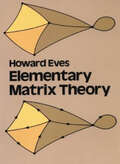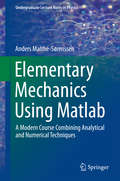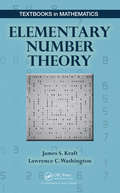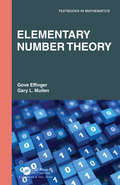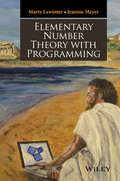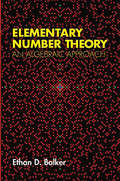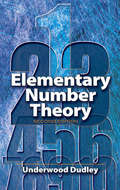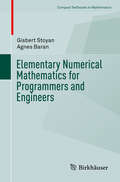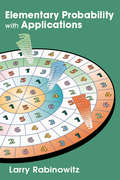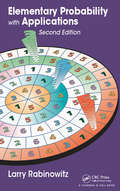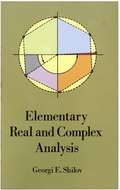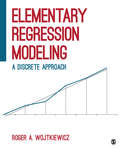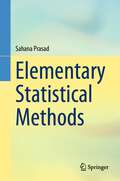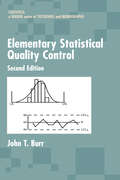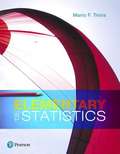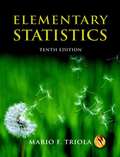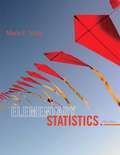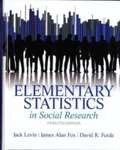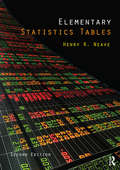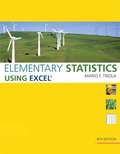- Table View
- List View
Elementary Matrix Theory (Dover Books on Mathematics)
by Howard EvesThe usefulness of matrix theory as a tool in disciplines ranging from quantum mechanics to psychometrics is widely recognized, and courses in matrix theory are increasingly a standard part of the undergraduate curriculum.This outstanding text offers an unusual introduction to matrix theory at the undergraduate level. Unlike most texts dealing with the topic, which tend to remain on an abstract level, Dr. Eves' book employs a concrete elementary approach, avoiding abstraction until the final chapter. This practical method renders the text especially accessible to students of physics, engineering, business and the social sciences, as well as math majors. Although the treatment is fundamental -- no previous courses in abstract algebra are required -- it is also flexible: each chapter includes special material for advanced students interested in deeper study or application of the theory.The book begins with preliminary remarks that set the stage for the author's concrete approach to matrix theory and the consideration of matrices as hypercomplex numbers. Dr. Eves then goes on to cover fundamental concepts and operations, equivalence, determinants, matrices with polynomial elements, similarity and congruence. A final optional chapter considers matrix theory from a generalized or abstract viewpoint, extending it to arbitrary number rings and fields, vector spaces and linear transformations of vector spaces. The author's concluding remarks direct the interested student to possible avenues of further study in matrix theory, while an extensive bibliography rounds out the book.Students of matrix theory will especially appreciate the many excellent problems (solutions not provided) included in each chapter, which are not just routine calculation exercises, but involve proof and extension of the concepts and material of the text. Scientists, engineers, economists and others whose work involves this important area of mathematics, will welcome the variety of special types of matrices and determinants discussed, which make the book not only a comprehensive introduction to the field, but a valuable resource and reference work.
Elementary Mechanics Using Matlab
by Anders Malthe-SørenssenThis book - specifically developed as a novel textbook on elementary classical mechanics - shows how analytical and numerical methods can be seamlessly integrated to solve physics problems. This approach allows students to solve more advanced and applied problems at an earlier stage and equips them to deal with real-world examples well beyond the typical special cases treated in standard textbooks. Another advantage of this approach is that students are brought closer to the way physics is actually discovered and applied, as they are introduced right from the start to a more exploratory way of understanding phenomena and of developing their physical concepts. While not a requirement, it is advantageous for the reader to have some prior knowledge of scientific programming with a scripting-type language. This edition of the book uses Matlab, and a chapter devoted to the basics of scientific programming with Matlab is included. A parallel edition using Python instead of Matlab is also available. Last but not least, each chapter is accompanied by an extensive set of course-tested exercises and solutions.
Elementary Number Theory
by James S. Kraft Lawrence C. WashingtonElementary Number Theory takes an accessible approach to teaching students about the role of number theory in pure mathematics and its important applications to cryptography and other areas. The first chapter of the book explains how to do proofs and includes a brief discussion of lemmas, propositions, theorems, and corollaries. The core of the tex
Elementary Number Theory (Textbooks in Mathematics)
by Gary L. Mullen Gove EffingerElementary Number Theory, Gove Effinger, Gary L. Mullen This text is intended to be used as an undergraduate introduction to the theory of numbers. The authors have been immersed in this area of mathematics for many years and hope that this text will inspire students (and instructors) to study, understand, and come to love this truly beautiful subject. Each chapter, after an introduction, develops a new topic clearly broken out in sections which include theoretical material together with numerous examples, each worked out in considerable detail. At the end of each chapter, after a summary of the topic, there are a number of solved problems, also worked out in detail, followed by a set of supplementary problems. These latter problems give students a chance to test their own understanding of the material; solutions to some but not all of them complete the chapter. The first eight chapters discuss some standard material in elementary number theory. The remaining chapters discuss topics which might be considered a bit more advanced. The text closes with a chapter on Open Problems in Number Theory. Students (and of course instructors) are strongly encouraged to study this chapter carefully and fully realize that not all mathematical issues and problems have been resolved! There is still much to be learned and many questions to be answered in mathematics in general and in number theory in particular.
Elementary Number Theory with Programming
by Jeanine Meyer Marty LewinterA successful presentation of the fundamental concepts of number theory and computer programming Bridging an existing gap between mathematics and programming, Elementary Number Theory with Programming provides a unique introduction to elementary number theory with fundamental coverage of computer programming. Written by highly-qualified experts in the fields of computer science and mathematics, the book features accessible coverage for readers with various levels of experience and explores number theory in the context of programming without relying on advanced prerequisite knowledge and concepts in either area. Elementary Number Theory with Programming features comprehensive coverage of the methodology and applications of the most well-known theorems, problems, and concepts in number theory. Using standard mathematical applications within the programming field, the book presents triangle numbers and prime decomposition, which are the basis of the public-private key system of cryptography. In addition, the book includes: Numerous examples, exercises, and research challenges in each chapter to encourage readers to work through the discussed concepts and ideas Select solutions to the chapter exercises in an appendix Plentiful sample computer programs to aid comprehension of the presented material for readers who have either never done any programming or need to improve their existing skill set A related website with links to select exercises An Instructor's Solutions Manual available on a companion website Elementary Number Theory with Programming is a useful textbook for undergraduate and graduate-level students majoring in mathematics or computer science, as well as an excellent supplement for teachers and students who would like to better understand and appreciate number theory and computer programming. The book is also an ideal reference for computer scientists, programmers, and researchers interested in the mathematical applications of programming.
Elementary Number Theory: An Algebraic Approach
by Ethan D. BolkerThis text uses the concepts usually taught in the first semester of a modern abstract algebra course to illuminate classical number theory: theorems on primitive roots, quadratic Diophantine equations, and the Fermat conjecture for exponents three and four. The text contains abundant numerical examples and a particularly helpful collection of exercises, many of which are small research problems requiring substantial study or outside reading. Some problems call for new proofs for theorems already covered or for inductive explorations and proofs of theorems found in later chapters.Ethan D. Bolker teaches mathematics and computer science at the University of Massachusetts, Boston.
Elementary Number Theory: Second Edition (Dover Books on Mathematics #41)
by Underwood DudleyIdeal for a first course in number theory, this lively, engaging text requires only a familiarity with elementary algebra and the properties of real numbers. Author Underwood Dudley, who has written a series of popular mathematics books, maintains that the best way to learn mathematics is by solving problems. In keeping with this philosophy, the text includes nearly 1,000 exercises and problems--some computational and some classical, many original, and some with complete solutions. The opening chapters offer sound explanations of the basics of elementary number theory and develop the fundamental properties of integers and congruences. Subsequent chapters present proofs of Fermat's and Wilson's theorems, introduce number theoretic functions, and explore the quadratic reciprocity theorem. Three independent sections follow, with examinations of the representation of numbers, diophantine equations, and primes. The text concludes with 260 additional problems, three helpful appendixes, and answers to selected exercises and problems.
Elementary Numerical Mathematics for Programmers and Engineers
by Gisbert Stoyan Agnes BaranThis book covers the basics of numerical methods, while avoiding the definition-theorem-proof style and instead focusing on numerical examples and simple pseudo-codes. The book is divided into ten chapters. Starting with floating number calculations and continuing up to ordinary differential equations, including "Euler backwards". The final chapter discusses practical error estimations. Exercises (including several in MATLAB) are provided at the end of each chapter. Suitable for readers with minimal mathematical knowledge, the book not only offers an elementary introduction to numerical mathematics for programmers and engineers but also provides supporting material for students and teachers of mathematics.
Elementary Numerical Mathematics for Programmers and Engineers (Compact Textbooks in Mathematics)
by Gisbert Stoyan Agnes BaranThis book covers the basics of numerical methods. Avoiding the definition-theorem-proof style, it instead focuses on numerical examples and simple pseudo-codes. The text begins with a chapter on floating point arithmetic before moving on to discuss norms, conditions numbers, solutions of systems of equations, the least squares problem, eigenvalue problems, interpolation, numerical integration, ordinary differential equations, optimization (including a detailed case study), and practical error estimations. Exercises (partly in MATLAB) are provided at the end of each chapter. Suitable for readers with minimal mathematical knowledge, the book not only offers an elementary introduction to numerical mathematics for programmers and engineers but also provides supporting material for students and teachers of mathematics.
Elementary Point-Set Topology: A Transition to Advanced Mathematics (Aurora: Dover Modern Math Originals)
by Andre L. Yandl Adam BowersIn addition to serving as an introduction to the basics of point-set topology, this text bridges the gap between the elementary calculus sequence and higher-level mathematics courses. The versatile, original approach focuses on learning to read and write proofs rather than covering advanced topics. Based on lecture notes that were developed over many years at The University of Seattle, the treatment is geared toward undergraduate math majors and suitable for a variety of introductory courses. Starting with elementary concepts in logic and basic techniques of proof writing, the text defines topological and metric spaces and surveys continuity and homeomorphism. Additional subjects include product spaces, connectedness, and compactness. The final chapter illustrates topology's use in other branches of mathematics with proofs of the fundamental theorem of algebra and of Picard's existence theorem for differential equations.
Elementary Probability
by David StirzakerNow available in a fully revised and updated new edition, this well established textbook provides a straightforward introduction to the theory of probability. The presentation is entertaining without any sacrifice of rigour; important notions are covered with the clarity that the subject demands. Topics covered include conditional probability, independence, discrete and continuous random variables, basic combinatorics, generating functions and limit theorems, and an introduction to Markov chains. The text is accessible to undergraduate students and provides numerous worked examples and exercises to help build the important skills necessary for problem solving.
Elementary Probability for Applications
by Rick DurrettThis clear and lively introduction to probability theory concentrates on the results that are the most useful for applications, including combinatorial probability and Markov chains. Concise and focused, it is designed for a one-semester introductory course in probability for students who have some familiarity with basic calculus. Reflecting the author's philosophy that the best way to learn probability is to see it in action, there are more than 350 problems and 200 examples. The examples contain all the old standards such as the birthday problem and Monty Hall, but also include a number of applications not found in other books, from areas as broad ranging as genetics, sports, finance, and inventory management.
Elementary Probability with Applications
by Larry RabinowitzProbability plays an essential role in making decisions in areas such as business, politics, and sports, among others. Professor Rabinowitz, based on many years of teaching, has created a textbook suited for classroom use as well as for self-study that is filled with hundreds of carefully chosen examples based on real-world case studies about sports, elections, drug testing, legal cases, population growth, business, and more. His approach is innovative, practical, and entertaining. Elementary Probability with Applications will serve to enhance classroom instruction, as well as benefit those who want to review the basics of probability at their own pace. The text is used at several colleges and for some high school classes.
Elementary Probability with Applications
by Larry RabinowitzElementary Probability with Applications, Second Edition shows students how probability has practical uses in many different fields, such as business, politics, and sports. In the book, students learn about probability concepts from real-world examples rather than theory. The text explains how probability models with underlying assumptions are used to model actual situations. It contains examples of probability models as they relate to: Bloc voting Population genetics Doubling strategies in casinos Machine reliability Airline management Cryptology Blood testing Dogs resembling owners Drug detection Jury verdicts Coincidences Number of concert hall aisles 2000 U.S. presidential election Points after deuce in tennis Tests regarding intelligent dogs Music composition Based on the author’s course at The College of William and Mary, the text can be used in a one-semester or one-quarter course in discrete probability with a strong emphasis on applications. By studying the book, students will appreciate the subject of probability and its applications and develop their problem-solving and reasoning skills.
Elementary Real and Complex Analysis
by Georgi E. ShilovIn this book the renowned Russian mathematician Georgi E. Shilov brings his unique perspective to real and complex analysis, an area of perennial interest in mathematics. Although there are many books available on the topic, the present work is specially designed for undergraduates in mathematics, science and engineering. A high level of mathematical sophistication is not required.The book begins with a systematic study of real numbers, understood to be a set of objects satisfying certain definite axioms. The concepts of a mathematical structure and an isomorphism are introduced in Chapter 2, after a brief digression on set theory, and a proof of the uniqueness of the structure of real numbers is given as an illustration. Two other structures are then introduced, namely n-dimensional space and the field of complex numbers.After a detailed treatment of metric spaces in Chapter 3, a general theory of limits is developed in Chapter 4. Chapter 5 treats some theorems on continuous numerical functions on the real line, and then considers the use of functional equations to introduce the logarithm and the trigonometric functions. Chapter 6 is on infinite series, dealing not only with numerical series but also with series whose terms are vectors and functions (including power series). Chapters 7 and 8 treat differential calculus proper, with Taylor's series leading to a natural extension of real analysis into the complex domain. Chapter 9 presents the general theory of Riemann integration, together with a number of its applications. Analytic functions are covered in Chapter 10, while Chapter 11 is devoted to improper integrals, and makes full use of the technique of analytic functions.Each chapter includes a set of problems, with selected hints and answers at the end of the book. A wealth of examples and applications can be found throughout the text. Over 340 theorems are fully proved.
Elementary Regression Modeling: A Discrete Approach
by Roger A. WojtkiewiczElementary Regression Modeling builds on simple differences between groups to explain regression and regression modeling. User-friendly and immediately accessible, this book gives readers a thorough understanding of control modeling, interaction modeling, modeling linearity with spline variables, and creating research hypotheses that serve as a conceptual basis for many of the processes and procedures quantitative researchers follow when conducting regression analyses.
Elementary Regression Modeling: A Discrete Approach
by Roger A. WojtkiewiczElementary Regression Modeling builds on simple differences between groups to explain regression and regression modeling. User-friendly and immediately accessible, this book gives readers a thorough understanding of control modeling, interaction modeling, modeling linearity with spline variables, and creating research hypotheses that serve as a conceptual basis for many of the processes and procedures quantitative researchers follow when conducting regression analyses.
Elementary Statistical Methods
by Sahana PrasadThis is the first book of two volumes covering the basics of statistical methods and analysis. Significant topics include concepts of research and data analysis, descriptive statistics, probability and distributions, correlation and regression, and statistical inference. The book includes useful examples and exercises as well as relevant case studies for proper implementation of the discussed tools. This book will be a valuable text for undergraduate students of statistics, management, economics, and psychology, wanting to gain basic understanding of statistics and the usage of its various concepts.
Elementary Statistical Quality Control (Statistics: A Series of Textbooks and Monographs)
by John T. BurrMaintaining the reader-friendly features of its popular predecessor, the Second Edition illustrates fundamental principles and practices in statistical quality control for improved quality, reliability, and productivity in the management of production processes and industrial and business operations. Presenting key concepts of statistical quality c
Elementary Statistics
by Mario TriolaThe 13th Edition is designed to be even more flexible, with the addition of learning objectives as an organizational tool, larger data sets, and new topics in line with advancements in statistics. In addition, readers will find more support in an all-new series of videos, more opportunities for practice, and improved support for statistical software.
Elementary Statistics (10th Edition)
by Mario F. TriolaThis book is an engaging and thorough introduction to statistics for students which allows students to apply their learned skills beyond the classroom in a real-world context and encourages thinking over the blind use of mechanical procedures.
Elementary Statistics (Twelfth Edition)
by Mario F. TriolaFrom SAT scores to job search methods, statistics influences and shapes the world around us. Marty Triola's text continues to be the bestseller because it helps students understand the relationship between statistics and the world, bringing life to the theory and methods. Elementary Statistics raises the bar with every edition by incorporating an unprecedented amount of real and interesting data that will help instructors connect with students today, and help them connect statistics to their daily lives. The Twelfth Edition contains more than 1,800 exercises, 89% of which use real data and 85% of which are new. Hundreds of examples are included, 91% of which use real data and 84% of which are new. New coverage of Ethics in Statistics highlights new guidelines that have been established in industry.
Elementary Statistics In Social Research
by James Fox Jack Levin David FordeThis best-selling introduction to statistical analysis in the social sciences provides the right balance of conceptual understanding and step-by-step computational techniques. The eleventh edition of Elementary Statistics in Social Research is written to be understandable to all readers, particularly those without a strong background in mathematics. This text is available in a variety of formats - print and digital. Check your favorite digital provider for your etext, including Coursesmart, Kindle, Nook, and more. To learn more about our programs, pricing options and customization, click the Choices tab. Learning Goals Upon completing this book, readers will be able to: Develop an understanding of the importance of statistics in the social sciences.
Elementary Statistics Tables
by Henry R. NeaveThis book, designed for students taking a basic introductory course in statistical analysis, is far more than just a book of tables. Each table is accompanied by a careful but concise explanation and useful worked examples. Requiring little mathematical background, Elementary Statistics Tables is thus not just a reference book but a positive and user-friendly teaching and learning aid. The new edition contains a new and comprehensive "teach-yourself" section on a simple but powerful approach, now well-known in parts of industry but less so in academia, to analysing and interpreting process data. This is a particularly valuable enabler to personnel who are not qualified in traditional statistical methods to actively contribute to quality-improvement projects. The second edition also includes a much-improved glossary of symbols and notation.
Elementary Statistics Using Excel
by Mario F. TriolaElementary Statistics Using Excel, Fourth Edition, offers a complete introduction to basic statistics, featuring extensive instruction on the use of Excel spreadsheets for data analysis. Extensive Excel instructions are provided along with typical displays of results, as well as information about Excel's limitations and alternative approaches to problem-solving. Real data in many examples help readers see the prevalence of statistics in the real world.
